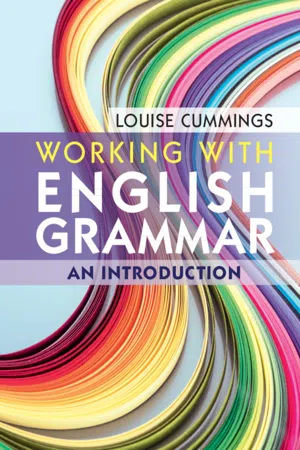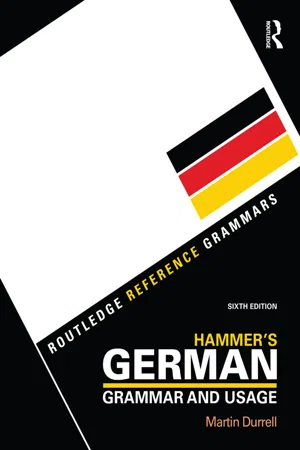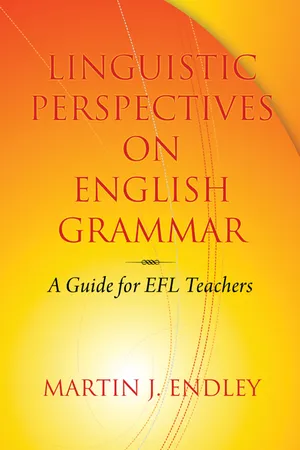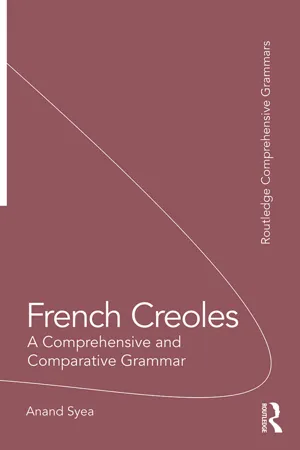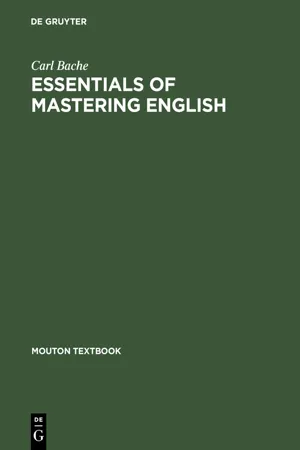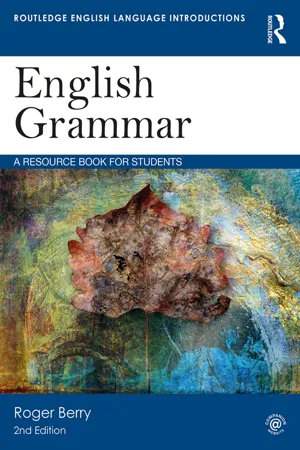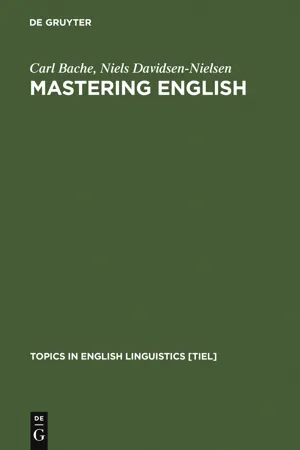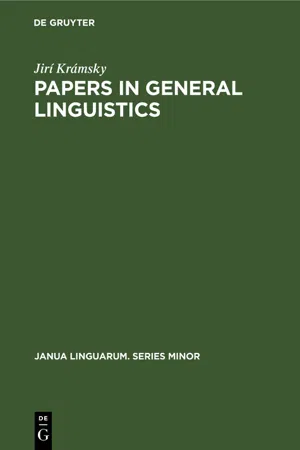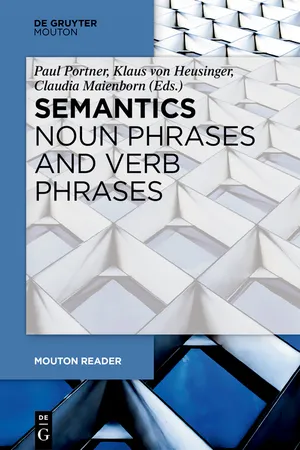Languages & Linguistics
Determiner
A determiner is a word that precedes a noun to introduce it or to specify its reference. It helps to clarify whether the noun is specific or general, and can also indicate quantity. Examples of determiners include articles (the, a, an), demonstratives (this, that), possessives (my, your), and quantifiers (some, many).
Written by Perlego with AI-assistance
12 Key excerpts on "Determiner"
- eBook - PDF
Working with English Grammar
An Introduction
- Louise Cummings(Author)
- 2018(Publication Date)
- Cambridge University Press(Publisher)
Determiners, prepositions and conjunctions are the small function words of lan- guage that link words, phrases and clauses together. When these words are missing from a child’s linguistic repertoire, the mean length of utterance is reduced and with it the complexity of the ideas that a child can communicate. The same is true of adults with language disorders. In adults with agrammatic aphasia, function words like Determiners, prepositions and conjunctions are often lost. The reten- tion of content words such as nouns and verbs allows these speakers to maintain some degree of meaningful communication notwithstanding the telegrammatic nature of their language. Still, the absence of function words places a significant burden on the hearer who must decide how grammatically isolated nouns and verbs are supposed to relate to each other. The language of clients with this type of aphasia very forcefully illustrates the grammatical significance of function words, and will be examined in this chapter. 4.2 Determiners Determiners are a group of little function words which come before the noun in a noun phrase. Their function is to convey further information about the noun such as quantity and number. Some noun phrases with their Determiners are underlined in the following sentences: She locked the door behind her. [Definite article] They watched a burglar enter the building. [Indefinite article] The delay added several hours to her trip. [Quantity word] Jane has two dogs at home. [Cardinal numeral] Mike won first prize for his marigolds. [Ordinal numeral] Jack sold his swimming pool. [Possessive Determiner] Frank wants those pots to be moved. [Demonstrative Determiner] Minor Word Classes 130 4.2.1 Definite and Indefinite Articles Let us take each Determiner in turn. The definite article (the) and the indefinite article (a/an) signal a difference in the knowledge that is shared between speakers/ writers and hearers/readers. - Anand Syea(Author)
- 2023(Publication Date)
- Routledge(Publisher)
3 DeterminersDOI: 10.4324/9781003458289-33.1 Introduction
This chapter looks at Determiners in English creoles. The Determiner class includes not only what Huddleston (1984, 234) refers to as central Determiners (e.g. articles, demonstratives, and possessives) but also other members such as quantifiers, numerals, and wh-pronouns. Section 3.2 provides a brief overview of Determiners in English while Section 3.3 looks at the different members of this class in English pidgins and creoles. The main members of this category that are considered in this section are the indefinite article (Section 3.3.1 ), the definite article (Section 3.3.2 ), demonstratives and their deixis reinforcers (Section 3.3.3 ), the possessives (Section 3.3.4 ), and other Determiners such as quantifiers and wh-specifiers (Section 3.3.5 ). Section 3.4 is a brief summary with some concluding remarks.3.2 Determiners in English
The Determiner class contains a group of words whose function is to specify the noun with which they occur. This class includes inter alia articles, demonstratives, and possessives. These are arguably the central members of this class. Other (non-central) members include quantifiers, numerals, wh-words such as who, what, and so on.Words such as a(n) and the in English are articles, and they contribute further semantic information to the nouns they precede. They tell us, for example, that the noun they introduce is indefinite as in Mary bought a dress or definite as in Mary bought the dress. When these sentences are uttered or read, we understand dress to mean ‘any dress’ in the former but a ‘specific dress’ in the latter. We, as hearers or readers, make use of these articles in order to determine how the nouns that they introduce should be interpreted. In English then there are two types of articles, namely the indefinite a(n) and the definite the. The indefinite article can also be understood as being specific if the speaker has a known individual or entity in mind John bought a shirt or I met a student in the hallway. The specificity meaning is clear when the indefinite noun phrase is replaced with a pronoun like it as in Mary was looking for a cat and she found it up a tree and the non-specificity meaning is equally clear when it is replaced with the indefinite pronoun one as Mary was looking for a cat and she found one. Only a non-specific a(n) can be replaced with the quantifier any. In addition to a(n) and the, English has a zero article, as in Bats are mammals. The noun bats is not introduced by either a(n) or the in this example, but may be said to have a zero article. Notice also that the noun phrase (NP) does not refer to an individual but to a whole class or set of individuals and is in this respect non-referential or generic. Note also that a zero article occurs only with plural nouns. Thus, while Dogs are barking is grammatical *Dog is barking- eBook - PDF
- Martin Durrell(Author)
- 2016(Publication Date)
- Routledge(Publisher)
5 Other Determiners and pronouns D ETERMINERS are a limited set of small words used with N OUNS to relate them to a particular context or situation. They typically occupy the first position in a N OUN PHRASE , before any adjectives. TABLE 5.1 The noun phrase: other Determiners Determiner Adjective/adjectival phrase Noun diese einige ihr jedes heidnische fleißige sehr elegantes in der Bundesrepublik geborene Gottheit Studenten Ensemble Kind The Determiners include the DEFIN ITE and IN DEFINITE ARTICLES , which are dealt with in Chapter 4 , and all other words used to determine nouns, like the DEMON STRATIVES ( dieser , jener , etc.), the POSSESSIVES ( mein , sein , etc.), the IN TERROGATIVES (e.g. welcher? ) and indefinites ( einige , etliche , etc.). PRON OUNS are a limited set of small words which stand in place of N OUNS or N OUN PHRASES . In particular they stand for nouns or noun phrases which have already been mentioned or which do not need to be repeated in full. They include the PERSON AL PRON OUNS , which are dealt with in Chapter 3 , DEMON STRATIVE PRONOUNS , POSSESSIVE PRON OUNS , IN TERROGATIVE PRONOUNS (asking questions), the RELATIVE PRON OUNS (the ‘who’, ‘which’ and ‘that’ words) and IN DEFINITE PRONOUNS . Determiners and pronouns qualify or stand in place of nouns and in German, they typically DECLIN E , i.e. they have endings which indicate the same grammatical categories as nouns – CASE , N UMBER and GEN DER . Table 5.2 gives the DECLEN SION of dieser ‘this’, which is one of the most frequent demonstratives and can be used as a Determiner or a pronoun. Many of the other Determiners and pronouns have the same endings as dieser . TABLE 5.2 Declension of dieser Masculine Feminine Neuter Plural Nominative Accusative Genitive Dative dies er dies en dies es dies em dies e dies e dies er dies er dies es dies es dies es dies em dies e dies e dies er dies en - eBook - PDF
- Martin J. Endley(Author)
- 2007(Publication Date)
- Information Age Publishing(Publisher)
The first thing that needs to be said is that this label indicates a grammatical function and that this function may be fulfilled by words from many different syntactic categories. The sentences in (1) have been chosen to illustrate the range of word-forms that can fulfill this function. For convenience, NPs appear in boxes; the words fulfilling the determining function are italicized. (1) a. I bought a CD from the store . b. I prefer this landscape to that portrait . c. My apartment is smaller than your office . d. All teachers have some bad lessons . e. She bought two dresses and three hats . The words a and the in (1a) are articles; this and that in (1b) are demon- stratives, my and your in (1c) are pronouns; all and some in (1d) are quanti- fiers (although some may also be considered a plural article); finally, two and three in (1e) are cardinal numbers. The point is that all these distinct word- forms can operate as determining words. In short, Determiner is a function label, not a category label. Linguists themselves are not always clear about this. Thus, Brinton writes—rather ambiguously, as it seems to me—that Determiners are “a subclass of words” (2000, p. 120). Here, much depends on what is under- stood by the term “subclass.” If it means a syntactic category, then I think this is wrong. As I have suggested, the term Determiner does not indicate a particular syntactic category. The point at issue may become clearer with an example. Consider (2) below: (2) I don’t like this book. I’m going to read this instead. It is an unfortunate fact that the labels that tend to be employed to describe this in examples like (2) actually confuse matters. Thus, you will sometimes read that the first this in (2) is a demonstrative Determiner, whereas Determining Words and Prepositions in Linguistic Perspective 115 in its second appearance it is a demonstrative pronoun. - eBook - ePub
French Creoles
A Comprehensive and Comparative Grammar
- Anand Syea(Author)
- 2017(Publication Date)
- Routledge(Publisher)
Determiners3.0 IntroductionThis chapter discusses the following members of the Determiner class: the indefinite Determiner, the definiteness and specificity Determiner, the demonstrative Determiner, and the possessive Determiner. It begins with a brief outline of Determiners in English and French and then discusses the Determiners in the different French creoles. The discussion focuses on the similarities and differences between these creoles in their choice of words to express definiteness and specificity, deixis, and possession. This chapter also discusses the loss of the French articles in the French creoles and the syntax and semantics of their definiteness and specificity marker.3.1 GeneralBare count nouns are impossible in a language like English except when they are in their plural form: She reads stories to children/*child , Children/*child like stories . In the singular, count nouns have to be accompanied by a Determiner, either the indefinite article a(n) or the definite article the , or a demonstrative this/that , or a possessive your , or a quantifier every : She is reading a story to a child. This child likes her stories , Your child likes her stories, Every child likes a good story . Without the Determiner, a singular count noun is simply impossible: * She is reading story to child , * Child likes her stories , * Child likes good story . Such a restriction also applies to nouns in French – interestingly, not only to singular nouns but also to plural ones. In the French creoles, this restriction on singular nouns can sometimes be relaxed depending on context.The Determiners in English, as in French, occupy pre-nominal position, and they can be separated from the noun they specify by one or more adjectives: a/the/this/your/every big black dog . They are also mutually exclusive: * a/the this book , * a/the my book , * an/the every book * that my book , * that every book * my every book , * every my book . However, the definite article can occur with the pre-Determiner quantifier all : all the books , as can the demonstrative and the possessive: all those books , all my books , but these have a partitive reading: all of the/those/my books . As is clear, the Determiners to the right of the preposition are all inside the PP and therefore not quite occurring alongside the Determiner all - eBook - PDF
Essentials of Mastering English
A Concise Grammar
- Carl Bache(Author)
- 2013(Publication Date)
- De Gruyter Mouton(Publisher)
170 Nomináis 14.3. Determination 14.3.1. Types of Determiner Determiners are used to signal the kind of reference involved in the expression of a nominal. There are four main subcategories of determination: (i) Definite determination. There are four form types realizing definite determination: a) the definite article the (as in the doctor, the bright girls); b) the demonstrative pronouns this, that, these, those (as in this bicycle, those bastards)·, c) the possessive pronouns my, your, his, her, its, our and their (as in my_ wedding, his student days)·, and d) genitive nomináis (as in Jack's truck, my old father's idea). To these types of definite determination we may add such, which is a demonstrative-like qualitative pronoun with subgeneric meaning: such misery, such students. (ii) Indefinite determination. There are three form types expressing indefinite determination: a) the indefinite article a(n) (as in a new hall, an arrogant journalist)·, b) zero (0) (as in professors, _ sugar)·, c) the indefinite pronouns any, no, each, every, either, neither, some (as in any suggestion, no joy, either way, some girl(s)). To these indefinite Determiners we may add one as an emphatic alternative to the indefinite article and another, which combines the indefinite article an and the modifier other (cf. the definite counterpart, which is in two words: the other). (iii) Interrogative determination. Interrogative determination is used to form a question about the head. There are three interrogative pronouns which may serve a determinative function: which, what and whose (as in Which book do you prefer? / What colour did she suggest? / Whose key is this?). (iv) Relative determination. Which, what and whose may also serve as relative Determiners (as in Her visitor left at four o'clock, by which time the FBI had already arrived/ He enjoyed what wine was left / The boy whose bike was stolen knocked on my door). - No longer available |Learn more
- Roger Hawkins, Richard Towell(Authors)
- 2015(Publication Date)
- Routledge(Publisher)
2 Determiners For the purposes of this grammar, the term 'Determiner' refers to three classes of items that modify nouns:- Articles : definite, indefinite and partitive
- Demonstrative Determiners
- Possessive Determiners
Definite articles indicate that the entity/concept referred to by the noun is uniquely identifiable by both speaker and hearer. If you say Passe-moi la fourchette ‘Pass me the fork’, both speaker and hearer know that there is a unique, identifiable ‘fork’ in the context in which the conversation is taking place.Indefinite articles are used with count nouns (bouteille ‘bottle’, billet ‘ticket’) and indicate that the entity/concept referred to by the noun is not sufficiently ‘known about’ or ‘specified’ to justify the definite article. If you say Passe-moi une fourchette ‘Pass me a fork’, this implies there is no uniquely identifiable ‘fork’ in the context of the conversation (perhaps because there are several of them).Partitive articles (du, de la, des ) serve the same function as indefinite articles, but are used with mass and abstract nouns: J’ai acheté du lait ‘I bought (some) milk’, Il faut avoir de la patience ‘You must have (some) patience’. The plural partitive article des is used with nouns that are mass or abstract by virtue of their meaning, but happen to be grammatically plural: des tripes (fpl) ‘tripe’, des cheveux (mpl) ‘hair’, des renseignements (mpl) ‘information’.Demonstratives are the forms ce/cet, cette, ces ‘this/these, that/those’. They indicate that the noun is seen as ‘known about’ or ‘specified’ largely in contrast to another noun: Passe-moi cette fourchette - eBook - ePub
English Grammar
A Resource Book for Students
- Roger Berry(Author)
- 2018(Publication Date)
- Routledge(Publisher)
Determiners are a very problematic group of words in a number of different ways. I have divided these various troubles into three levels: for linguists, for applied linguists, and for learners/teachers. One might characterise these as being analysis, (pedagogic) description, and application respectively. The borderline between them is arbitrary to some extent, and a problem may apply to more than one of them. However, generally they represent stages in what may be called ‘the process of pedagogic grammar’.Troubles for linguists
Are Determiners a valid word-class?
The first issue is whether Determiners are distinguishable as a class from e.g. pronouns (with which they were conflated in earlier treatments of English). According to Hudson (1990) the answer is no: there is a generalisation that will be missed if we follow the normal practice and treat Determiners and pronouns as two unrelated word-classes’ (1990:269). This generalisation is that most words that are Determiners can also function as pronouns, for example that:I don’t like that idea much.That was many years ago.The exceptions to this are a/an, the, no, every, plus my, your, her, our and their , which cannot be used as pronouns. Of these the possessives can easily be excluded since they have readily available pronoun counterparts (mine , etc). Likewise, no has a counterpart in none. Every is more problematic, unless one accepts that every one (not everyone , of course, which can only refer to humans) is a pronominal counterpart. This would then only leave the articles; these can be accounted for by saying that they are the basic Determiners in that they add nothing to the meaning of a noun phrase apart from the basic idea of definiteness or indefiniteness.After the above prestidigitation, the case for establishing Determiners as a distinct class would seem to be rather thin. Similarly, in terms of meaning, there are few reasons for a distinction. In certain cases the use of a word as a pronoun implies human reference, as in the examples below, whereas there would be no such restriction of interpretation for a Determiner.He returned home a global figure, an almost godlike figure for some .Thos e determined to kill can always find suitable opportunities.In addition, there is often a degree of formality associated with certain pronominal uses, as the two examples show, which is absent from the Determiner. (This is discussed further below.) But in the vast majority of cases the meaning of the Determiner and the pronoun are the same. - eBook - PDF
Mastering English
An Advanced Grammar for Non-native and Native Speakers
- Carl Bache, Niels Davidsen-Nielsen(Authors)
- 2010(Publication Date)
- De Gruyter Mouton(Publisher)
360 Nominate 10.3. Determination 10.3.1. Types of Determiner Determiners are used to signal the kind of reference involved in the expression of a nominal. There are four main subcategories of determination: (i) Definite determination. There are four form types realizing definite determination: a) the definite article the (as in the doctor, the bright girls); b) the demonstrative pronouns this, that, these, those (as in this bicycle, those bastards); c) the possessive pronouns my, your, his, her, its, our and their (as in my wedding, his student days); and d) genitive nominals (as in Jack's truck, my old father's idea). To these types of definite determination we may add such, which is a demonstrative-like qualitative pronoun with subgeneric meaning: such misery, such students. (ii) Indefinite determination. There are three form types expressing indefinite determination: a) the indefinite article a(n) (as in a_ new hall, an arrogant journalist); b) zero (0) (as in _ professors, _ sugar); c) the indefinite pronouns any, no, each, every, either, neither, some (as in any suggestion, UQ_joy, either way, some girl(s)). To these indefinite Determiners we may add one as an emphatic alternative to the indefinite article and another, which combines the indefinite article an and the modifier other (cf. the definite counterpart, which is in two words: the other). (iii) Interrogative determination. Interrogative determination, which is often indefinite in character, is used to form a question about the head. There are three interrogative pronouns which may serve a determinative function: which, what and whose (as in Which book do you prefer? / What solution did she come up with? /Whose key is this?). (iv) Relative determination. Which, what and whose may also serve as relative Determiners with more definite meaning (as in Her visitor left at four o'clock, by which time the FBI had already arrived /He enjoyed what wine was left / The boy whose bike was stolen knocked on my door). - eBook - ePub
Noun Phrases in Australian Languages
A Typological Study
- Dana Louagie(Author)
- 2019(Publication Date)
- De Gruyter Mouton(Publisher)
There are also some issues which cannot be resolved in a typological analysis, but that require deeper analysis of individual languages. One is structural: in some languages there is no clear boundary that separates the Determiner zone from other modifiers. This is especially the case for some languages of type 2 and type 4. An example is Kuuk Thaayorre, for which the NP template is given in (200) (in a simplified form, see also (130a)). All modifiers, except for the adjective, are potential Determiners. Demonstratives and ignoratives are most likely part of a Determiner zone, as these elements usually are in Australian languages, but it is unclear whether the quantifier and possessive pronoun are Determiners here, as they are elements which are also often found in other functions across Australian languages.(200)Kuuk Thaayorre (Gaby 2017 : 195)Template (G): (N) ((Deg) Adj (Deg))* (Poss) (Quant) (DemPron/ IgnPron) (AdnDem)Another interesting question concerns the functional motivation for using multiple Determiners. A straightforward explanation is that each element contributes its own specific semantics (such as definiteness, possession or location), and in combination the elements ‘determine’ the NP, locating it in the context of the speech event or of the discourse. Interestingly, the use of multiple Determiners also seems to correlate with certain functions in discourse. An example is the repetition of the same demonstrative in Ungarinyin, which serves to contrast two referents, as in example (201), where the name that JE mentions contrasts with the more specific names PN has in mind (Spronck 2015 : 175–176).129 In Bundjalung, the combination of a visible and a non-visible demonstrative serves to (re-)introduce a referent in (202) (Sharpe 2005 - eBook - PDF
- Jirí Krámsky(Author)
- 2019(Publication Date)
- De Gruyter Mouton(Publisher)
17 We have chosen for our examination four ways of expressing the category of determinedness and indeterminedness with the exclusion of the formally independent article. These ways of expressing this category are no sporadic phenomena, they occur in a considerable number of languages so that we can say that they represent certain characteristic tendencies in grammatical thinking of some nations. If we want to give a general evaluation of the examined cases of different expression of the category of determinedness, we must first of all state that this phenomenon is rather complicated and diversified. The question naturally arises how to explain that diversity. Considering the category of determinedness in its entirety, it is evident that we may distinguish two groups of languages: on one hand the languages in which determination is expressed by articles, either an independent or enclitic or proclitic one, but this article influences only the noun or the attributive adjective re-spectively. On the other hand there are languages in which determi-nation is not only the matter of nouns but interferes, more or less, with the syntactic level. This is most pregnant, as we have seen, in Samoyed languages where the use of the determinate form is directly bound to certain sentence types. As we have tried to show, not mere determination is concerned here but determination plus some desideratum. A considerably convincing evidence of this syntactic function is given, according to our opinion, by Finno-Ugric languages which do not have in all dialects the accusative suffix and where predicate can point to the definiteness of the accusative object through its being expressed by objective con-17 Cf. W. Davidson, A Preliminary Analysis of Active Verbs in Dogrib, Studies in the Athapaskan Languages, University of California Publications in Linguistics 29 (Berkeley and Los Angeles, 1963), 48-55. - eBook - PDF
- Paul Portner, Klaus Heusinger, Claudia Maienborn, Paul Portner, Klaus Heusinger, Claudia Maienborn(Authors)
- 2019(Publication Date)
- De Gruyter Mouton(Publisher)
Edward Keenan 4 Quantifiers 1 Introduction 112 2 Scope of the present study 113 3 Determiner Quantifiers 114 4 Extending the logical type of Determiners 131 5 Adverbial Quantifiers 137 6 Concluding remarks 143 7 References 143 Abstract: The presentation distinguishes broadly between Determiner (D-) Quantification and Adverbial (A-) Quantification, with the former being much better studied and understood than the latter. We present D-quantification first and use it to study novel types of quantification such as polyadic quantification and mass term quantification. Then we extend the concepts developed to A-quantification. We characterize semantically over 20 types of Determiner quantification in natural language, focusing on questions of logical expressive power—what we can say and what constraints there are on what we can say. We do not focus on the formalization of syntactic representations, though we do show that there are quantifiers denotable by syntactically complex Determiners that are not denota-ble by syntactically simple Determiners. We do this within the broad framework of Generalized Quantifier Theory. In terms of the semantic categories of analysis developed we offer several non-obvious semantic generalizations which hold for well studied languages and which we think may hold more generally. In two cases we explicitly suggest that the properties are language universal. 1 Introduction Quantifiers expressible in natural language have played an important role in linguistic theory since the early days of generative grammar when sentence pairs like Everyone in this room speaks two languages and Two languages are spoken by everyone in this room were argued to exhibit different quantifier scope rela-tions, whence transformations such as Passive were not meaning preserving. See Katz & Postal (1964). Later generative grammar would include a level of LF, May https://doi.org/10.1515/9783110589443-004 Edward Keenan, Los Angeles, CA, United States
Index pages curate the most relevant extracts from our library of academic textbooks. They’ve been created using an in-house natural language model (NLM), each adding context and meaning to key research topics.
